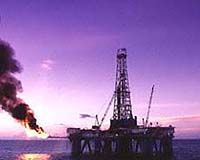 |
Stanley, Falkland Islands (UPI) Dec 3, 2010 Desire Petroleum, which has staked shareholder capital on finding commercially viable quantities of oil in the South Atlantic's North Falkland Basin, said its latest drilling held promise of a discovery it could work with. The company made the announcement after fresh drilling of the so called 14/15-2 Rachel North well reached a new depth of about 10,000 feet. Desire Petroleum plc, a U.K. company listed on the Alternative Investment Market, was one of the first prospectors to enter the fray but has trailed other companies actively seeking to strike significant oil below the North Falkland Basin seabed. The oil quest has coincided with an increasingly bitter war of attrition between Argentina and Britain over Argentine claims of sovereignty. Argentina maintains the London-ruled Overseas Territory is a vestige of British colonialism and should go under Argentine rule as Las Malvinas. Argentine claims on the Falklands culminated in an invasion in 1982 that was repulsed by Britain. The 74-day conflict led to 1,000 deaths of fighters from both sides and some Falklands civilians. The Argentine claims hardened as the oil prospecting progressed. Last week Argentina won support from Latin American neighbors in what promises to be a campaign to block the Falklands' shipping trade. British, Falkland and other shareholders have staked millions on a major oil find, which some surveys suggest may turn out to be bigger than the North Sea reserves. Results so far are not encouraging, however, but analysts insist that may change. A Desire Petroleum announcement struck a note of cautious optimism. A technical update laced with industry jargon said preliminary data indicate that "this well is an oil discovery," the company said. Desire "has run an initial suite of wireline logs and this together with the drilling data indicate that the well encountered a 349-meter gross interval from 2,621 meters to 2970 meters of sands and shales with hydrocarbons, of which 57 meters is net pay in multiple zones," the company said. Oil industry analysts and geologists differ when defining oil well net pay, but it usually sums up the quantity of explored mass that can be used to produce commercially viable quantities of oil. "The thickest zone is 8 meters thick with an average porosity of 20 percent. Other zones are thinly bedded and lower porosity but require further analysis from additional wireline logs to establish reservoir potential," Desire said. "Desire now intends to complete the wireline logging and wireline sampling program to obtain more information on the reservoir quality, the hydrocarbon saturations and the fluid type to assess the significance of this discovery." It promised to provide more information later. Desire Chairman Stephen Phipps termed "highly encouraging" news of the initial drilling results from the Rachel North well. He said the new discovery, combined with Rockhoppers' Sea Lion earlier discovery, confirmed the prospecting firms' belief the North Falkland Basin was "highly prospective and that further oil fields will be discovered in this area." At least six oil prospecting firms are actively looking for oil and gas in the Falklands waters, much to public fury of Argentine government officials.
Share This Article With Planet Earth
Related Links Powering The World in the 21st Century at Energy-Daily.com
 China will pump 40 billion dollars in Venezuela energy
China will pump 40 billion dollars in Venezuela energyCaracas (AFP) Dec 2, 2010 China will invest more than 40 billion dollars in Venezuela's oil- and gas-rich eastern Orinoco belt by 2016, Energy Minister Rafael Ramirez told a meeting of gas exporters in Qatar Thursday. Ramirez said China Petroleum and Chemical Corporation (Sinopec) would invest in oil extraction projects in the Junin 1 and Junin 8 blocs, while China National Oil Off Shore (CNOOC) would undertake gas p ... read more |
|
| The content herein, unless otherwise known to be public domain, are Copyright 1995-2010 - SpaceDaily. AFP and UPI Wire Stories are copyright Agence France-Presse and United Press International. ESA Portal Reports are copyright European Space Agency. All NASA sourced material is public domain. Additional copyrights may apply in whole or part to other bona fide parties. Advertising does not imply endorsement,agreement or approval of any opinions, statements or information provided by SpaceDaily on any Web page published or hosted by SpaceDaily. Privacy Statement |